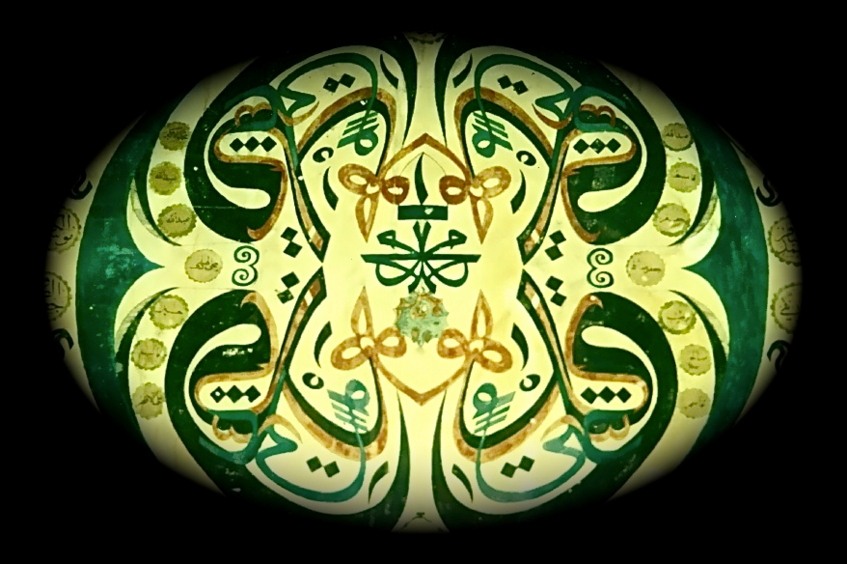The Visual Culture of Sufism in Vienna: Ways of Viewing in the Mystical Islam of the Chishti-Inayati and the Halveti-Jerrahi

In the quest to find grounds for engagement between Islam and the West, mysticism provides a valuable bridge between the two. This research project aims to provide insights into an important aspect of the religious visual culture of “mystical Islam” or Sufism in Vienna. Although Islam—just like Judaism and Christianity—has a tradition that includes the prohibition and destruction of images, visual images nonetheless play an essential role in this religious life-management practice. They organise the communication with the transcendent, they serve to build a collective memory, and they create religious meaning by connecting the religious sense-system with the feelings of the observer through the use of imagination. Visual signs, then, shape and restrict the scope of the identity-forming forces that brought them into being.
The history of debates in the monotheistic traditions over the role of pictorial representation is characterised by reciprocal delimitations, attributions, and identifications. The prejudice that the Quran forbids images and that Islamic art is iconophobic is often linked to a discourse about the “Islamisation” of contemporary Western European life that has played an instrumental role in discussions of European identity. At the same time, the views underlying the prejudice are used by Islamists as a justification for the total destruction of cultural heritage, exemplified by the shattering of Assyrian and Parthian sculptures in the Museum of Mosul at the hands of the so-called Islamic State (ISIS), as well as the demolition of the most important ancient ruins of Palmyra in 2015.
Given this context, it is important to make available to the public the visual culture of the mystical elements of Islam that are the subject of this project. Within this mystical tradition, a symbolic visual language was cultivated and serves as an important signifier or bearer of meaning. This visual language also shows that theological dogmas and popular practices do not necessarily correspond.
In Vienna we can find individuals, often coming from a Muslim context, who are affiliated with all the great classical orders of Sufism. In addition, the city hosts converts from the Western world who are particularly attracted to Islamic mysticism or Sufism. And there are also communities who try to convey Sufi spirituality to the Western world in a non-Islamic context. The latter, too, consider themselves to be heirs of classical Sufism, especially with regard to its universalistic conceptions, which traverse the boundaries of conventional Islam.
In order to adequately understand the universal religious ideas of Sufism, it is necessary to take into account the modern self-image of the classical Sufi orders. This project will investigate the visual culture of two of these orders. The first subject of this study will be the visual culture of the Inayati Order which goes back to Hazrat Inayat Khan, an acknowledged Pir (spiritual leader) in the lineage of the Chishti Sufi Order of India. The current spiritual head of the order is Pir Zia Inayat Khan, who builds on the life’s work of his father, Pir Vilayat Inayat Khan (1916–2004), who directed the order until his death, and that of his grandfather, Hazrat Pir Murshid Inayat Khan (1882–1927), who had already been active in North America—and later in Europe—at the beginning of the twentieth century. With their origins in the pursuit of a mystical union with God, the order’s teachings are characterised by a universalistic spiritual understanding. The groups belonging to this spiritual movement in Vienna are the subject of this research. It is particularly noteworthy that all teaching and pastoral counselling tasks, as well as all leadership functions, are borne equally by women and men. For this reason, the present research project is particularly concerned with female spiritual competence and the feminine elements in Sufism.
The project will also examine the visual culture of the Jerrahi (Turkish: Cerrahî) in Vienna, one of the numerous classical Sufi orders of Islam and a branch of the Halveti (Arabic: Khalwati) order. One of its most famous adherents in the West is Muzaffer Ozak al-Jerrahi al-Khalwati (1916–1985), a charismatic shaykh of the Jerrahi Sufi order in Istanbul. The 19th successor to the order’s founder, Pir Nureddin al-Jerrahi al-Khalwati, made several trips to Western Europe and the USA from the end of the 1970s to present the dervish ceremony to the public. Through his travels, he was able to attract a large number of followers on all continents. This project will examine the visual culture of the Vienna-based followers of this Sufi order, who take part in meditative practices for the remembrance of God (dhikr) and also engage in other spiritual and ceremonial rituals.
A common feature of both orders is the possibility of experiences that transcend the usual, regulated forms found in mainstream Islam. A central working hypothesis is that visual culture and religious practice both drive forward, and indeed foster, religious pluralisation.
